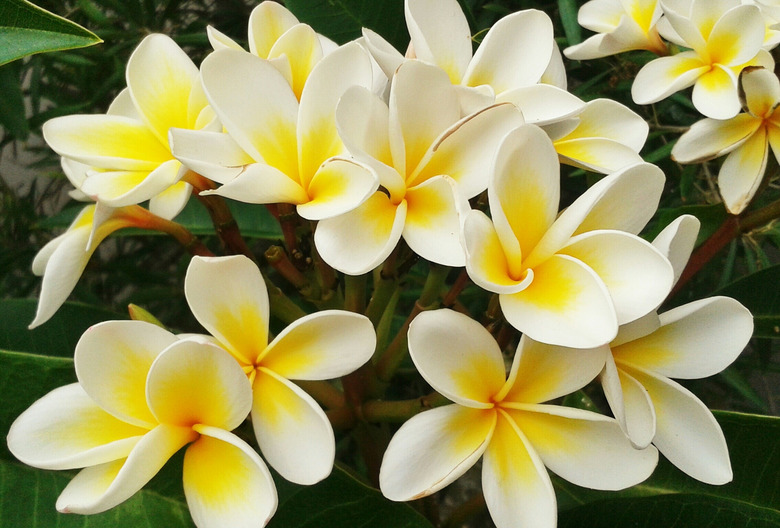How To Care For Plumeria
We may receive a commission on purchases made from links.
A beautiful plant with fragrant flowers, plumeria (Plumeria spp., USDA zones 10-12) is a favorite among gardeners and horticultural enthusiasts, and learning to care for plumeria properly helps these fragrant flowers flourish. Recreating the plumeria's tropical environment with warm temperatures and ample humidity helps it grow well. Regular watering and fertilizing provides the plumeria with the nutrients and moisture it needs.
What Is Plumeria?
What Is Plumeria?
Best known as the flower of choice in Hawaiian leis, plumeria is a tropical tree that yields fragrant flowers that are waxy to the touch. Stems are thick and tough, and leaves are large and leathery. A tropical species, plumeria require an abundance of sunlight, water and warmth to reach its healthiest state.
Plumeria Environmental Needs
Plumeria Environmental Needs
Because these plants are native to tropical regions, their surroundings should mimic these conditions as closely as possible. Warm climates, typically between 70 and 80 degrees Fahrenheit, make for the happiest plumeria plants. If you live in an area where temperatures drop below 40 degrees, keep the plumeria in a container that's easily transportable so you can bring the plant indoors during winter keep it protected from chills and frost.
Plumeria also needs an adequate amount of sunlight to thrive and flower, so place your plant in a spot where it can enjoy full sun or partial shade for four to six hours per day. If your home doesn't get great direct light, you can keep your plant under a grow light. Just add about ten hours to the exposure time. Without adequate light, your plant won't produce flowers.
Care for Plumeria: Watering
Care for Plumeria: Watering
As plumeria is used to humid surroundings, it needs to be watered, on average, about one inch per week, depending on the size. Like most plants, however, too much water can result in unhappy roots. Keep your plant in a container with adequate drainage to prevent possible issues like root rot, which can kill the plumeria. Using cactus potting soil also helps prevent root rot since it promotes good drainage.
Fertilizing Plumeria Plants
Fertilizing Plumeria Plants
One way to ensure the care of your plumeria plant is with regular fertilizing, which will help it grow and possibly flower. To nourish your plant, look for a high-phosphorus water-soluble product that's low in nitrogen for the best results. Stick to a feeding schedule of every two to four weeks during the growing season. Stop fertilizing the plant when it goes dormant, and resume the feeding schedule in the spring when it starts to grow again.
Plumeria Care Considerations
Plumeria Care Considerations
Some plumeria plants are prone to insect infestations. To keep your plant free of possible pests like spider mites or mealy bugs, check its leaves and stems regularly. If you find bugs on your plumeria plant, keep them under control with insecticidal soap or neem oil, the latter of which is great for spot-treating problems as they arise. Always observe all label directions and precautions.
While plumeria is mostly admired for its gorgeous flowers, getting a plant to grow indoors is not always an easy task, so try not to get too frustrated if your plant isn't yielding petals right away. Most plants need to mature to flower. If your plant is less than two or three years old, just keep sticking to a regular routine and be patient.
